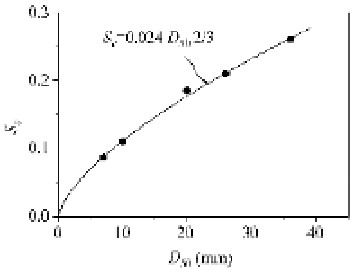Environmental Engineering Reference
In-Depth Information
4.3.2.2
Critical Bed Gradient for Initiation of Debris Flow
There is a critical bed gradient, s
c
, below which no debris flow can be initiated for a given bed gravel
composition. The coarser the bed materials, the higher is the critical slope. Figure 4.35 shows the critical
slope as a function of the median diameter of the bed material, which is mathematically expressed as:
2/3
s
0.024
D
(4.5)
50
in which
D
50
is the median particle diameter in millimeters. From Eq. (4.5) it can be determined that
debris flow may be initiated on a gentle slope if the bed material is not coarse. Field data have proven
that in most cases a gully is a debris flow gully if its slope is greater or a non-debris flow gully if its
slope is smaller than the critical value given by Eq. (4.5). In other words, for a gully with a given slope, it
can become a debris flow gully if there is plenty of fine gravel on the bed, or it is a non-debris flow gully
if the bed material is coarse.
Takahashi (1978, 1980) presented a model of the initiation of debris flow. From his model debris flow
can be initiated if the shear stress of the flow is greater than the shear resistance of a layer of debris
deposits. The layer then will slide down the slope and move with the flowing liquid, therefore, debris flow
develops as a result of the mixture of the solid deposit and the liquid. Takahashi (1978, 1980) found the
critical slope for debris flow development to be about 14.3° or
s
c
= tan 14.3° = 0.23. Takahashi's model
can be applied to landslides and the debris flows developing from landslides but not to the debris flow
resulting from bed erosion caused by a torrential flood. The critical slope for a flood-caused debris flow
is smaller than that given by the shear stress model. The median diameter of bed materials of the Jiangjia
Gully is about 5-12 mm. Equation (4.5) gives a critical slope of about 0.13. The slope of the upstream
portion of the gully is about 0.15 and there are plenty of loose solid deposits in the area. Therefore,
debris flows often occur in the gully if the rainfall intensity is higher than 0.5 mm/min.
Fig. 4.35
Critical slope for initiation of debris flow as a function of the median diameter of bed material (after
Wang et al., 2005)
4.3.2.3
Height of Debris Flow Head
Generally, the head grows at the beginning of the debris flow development and then reaches an equilibrium
height. Figure 4.36 shows the growth process of the debris flow head following the propagation down the
flume, in which
L
is the distance from the entrance and
h
d
is the height of the debris flow head. Miyazawa
(1998) obtained similar results from debris flow experiments with gravel of diameter of 5-10 mm.
The experiments of Wang et al. (2005) also revealed that debris flow can be triggered only if the
incoming flow discharge is sufficiently high even if the bed gradient is over the critical value. If,
however, a debris flow is triggered, the front head is high and steep. The height of the debris flow head
depends mainly on the size of the gravel in the debris flow. The height of the debris flow head in the


Search WWH ::

Custom Search